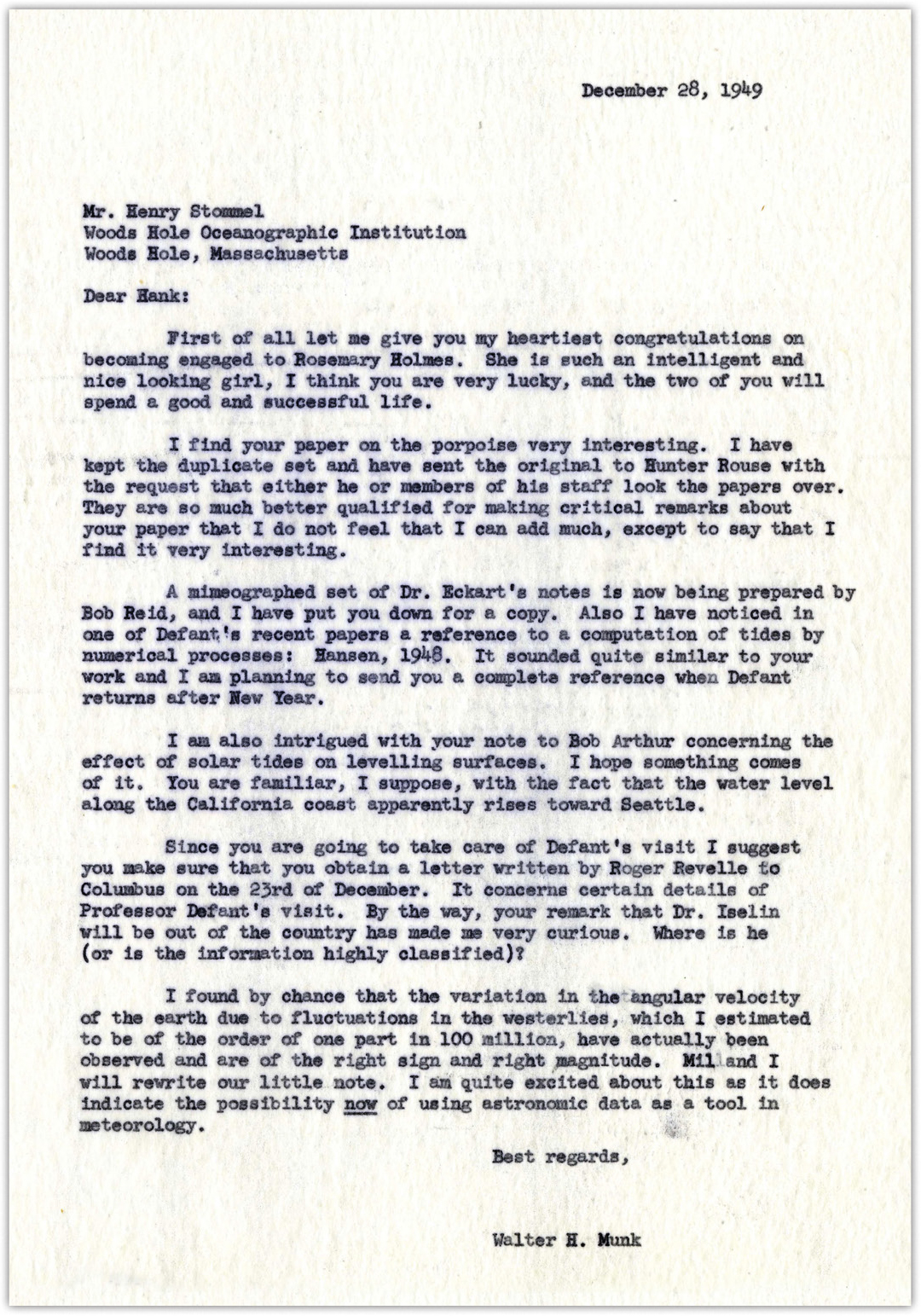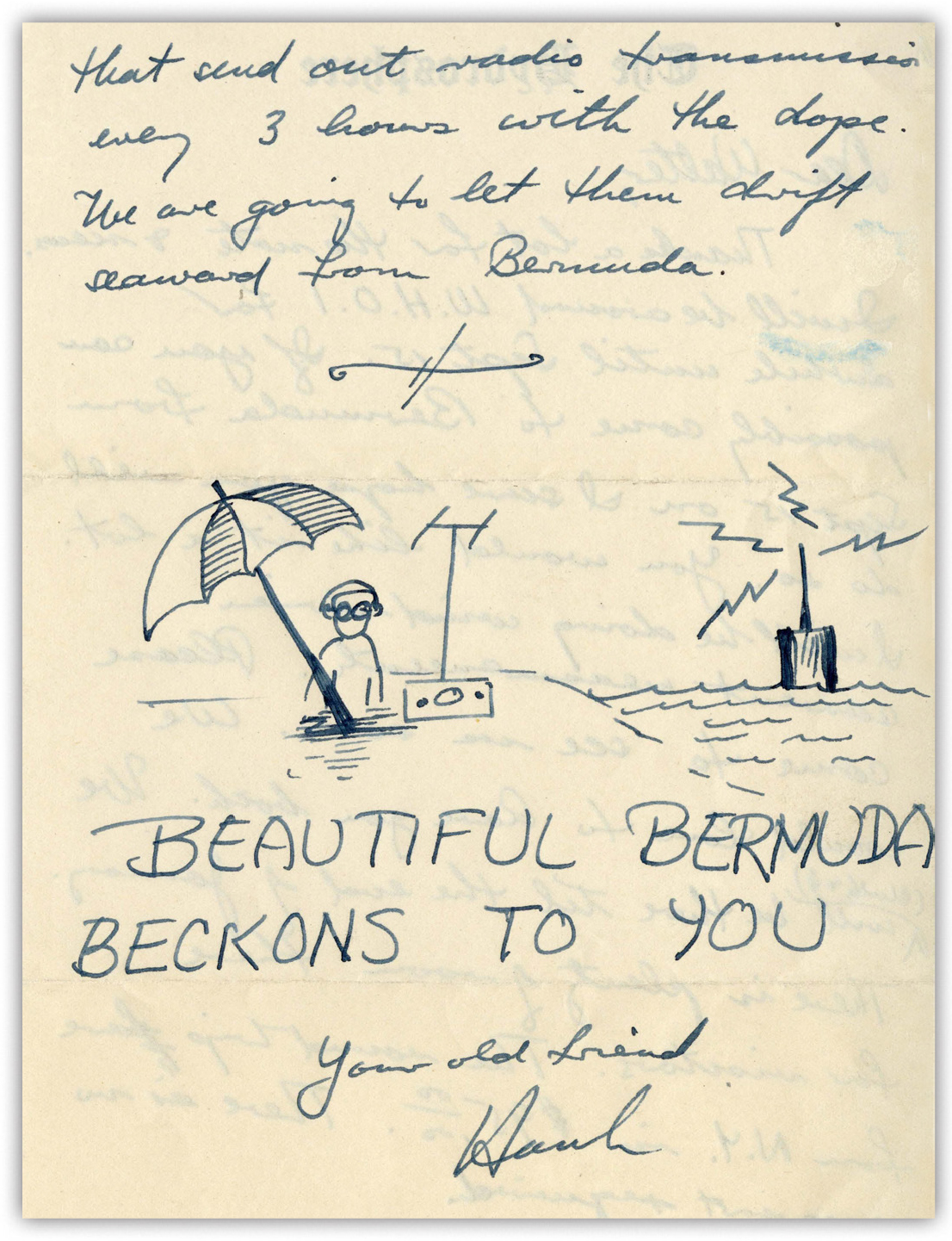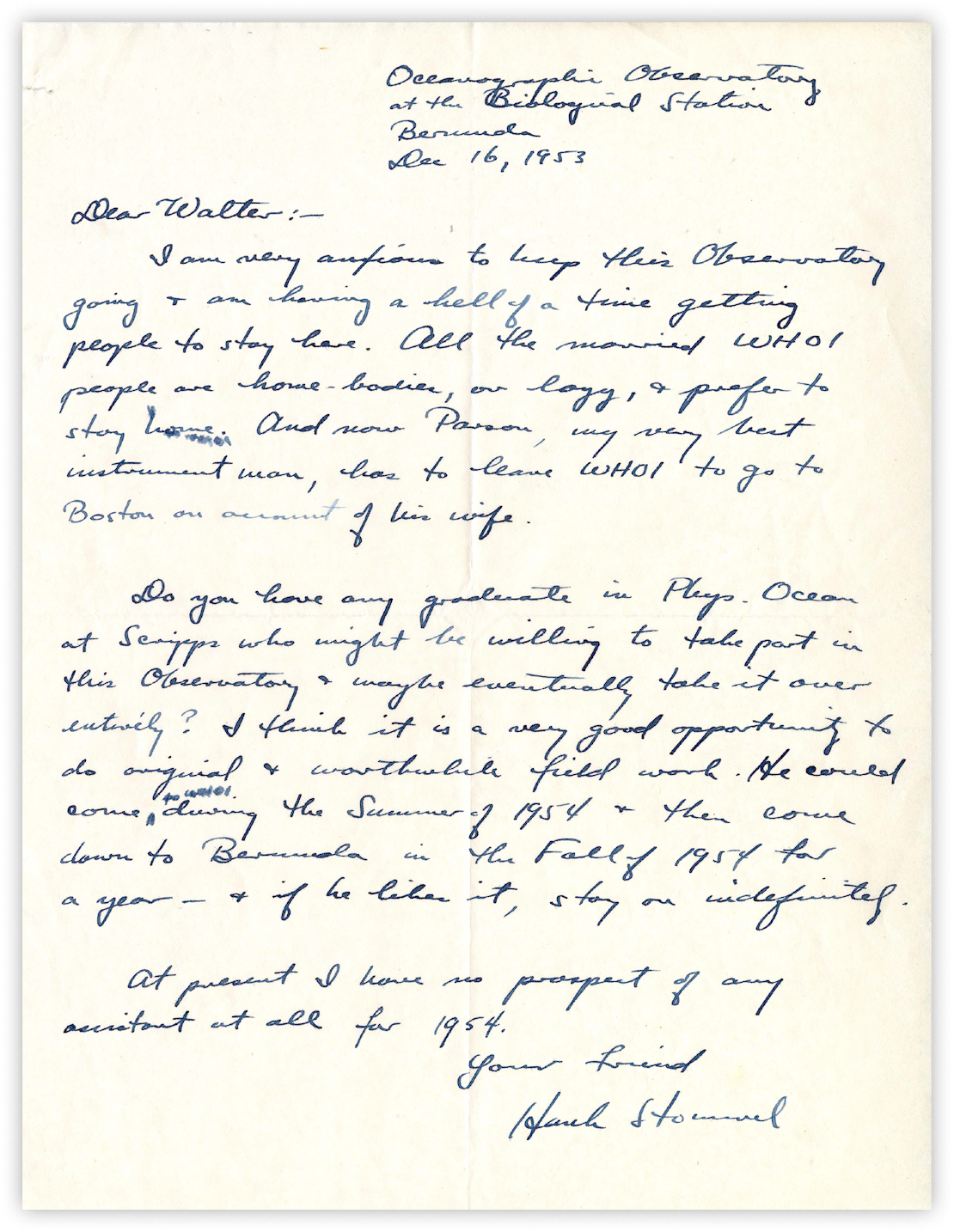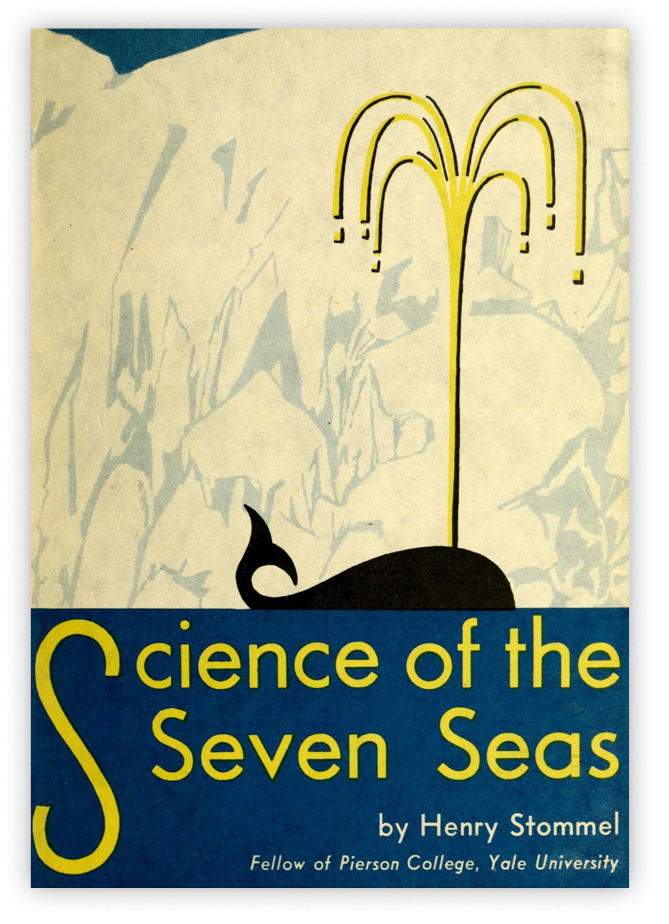Full Text
Two of the dominating figures of twentieth century physical oceanography/geophysics were Henry (Hank) Stommel and Walter Munk, whose early correspondence is discussed here. Stommel worked on the East Coast at the Woods Hole Oceanographic Institution (WHOI), the Massachusetts Institute of Technology, and Harvard University from 1944 to 1992, when he died at age 71. Munk’s career was based on the West Coast at Scripps Institution of Oceanography (SIO), University of California San Diego, from 1941 until his death at age 101 in 2019. Both were well recognized during their lifetimes, and a number of descriptions of their lives and works are listed in a bibliography at the end of this note. An intended centenary observation for Stommel was planned for September 2020 but was postponed because of the pandemic. Anyone fortunate enough to have known these two oceanographers would have recognized the remarkable differences in their personalities and lives.
In the process of attempting to document the scientific achievements of these men, an exchange of letters between them in the period onward from 1947 came to light in the UC San Diego (UCSD) Library’s Special Collections & Archives (see Acknowledgments). Reading through the available correspondence (with inevitable evidence of gaps), one is struck by the great cordiality, collegiality, and clear evidence of their enjoyment of each other’s company; their mutual interests in dynamical oceanography and its biological implications; and the great diversity of scientific problems in which they had a joint interest.
The Physical Correspondence
The correspondence material available to me consists only of that produced through the good auspices of Laurel McPhee of the UCSD library, as well as the online published material of Walter Munk and Henry Stommel. That correspondence consists of scanned copies of their letters that were available in the Munk Archive. As such, the Munk end of the correspondence is carbon copies of what were clearly secretary-typed letters (Figure 1). The Stommel end is largely, but not completely, handwritten letters for which the existence of a copy anywhere is doubtful. Later in the correspondence, some of Stommel’s letters are a mixture of his own typing and those of a professional. A few letters to and from Roger Revelle, Scripps Director from 1950 to 1964, presumably copied to Munk, are included as well.
|
|
At the beginning of the period, Walter Munk was 29 years old, and Henry Stommel was 26—two young scientists starting out. Their letters are a glimpse into ways of doing science that are now almost as remote from the modern form as are those of the 1870s HMS Challenger Expedition. Readers will note some interesting quirks, often related to the mores of the time. Harald Sverdrup is always “Dr. Sverdrup” in Munk’s letters. Stommel, as was his wont, sometimes used home-printed letterheads and addresses that ranged from the fanciful Central Bureau, The Hydrosphere, and The Observatory, Bermuda Biological Station.
As this note was written during the coronavirus apocalypse shutdown by a non-historian, professional science historians will recognize its incompleteness. Allusions exist to missing letters and manuscripts. Munk in particular had a well-known habit of intermittently clearing his office by simply throwing everything away. Production of a full discussion of this period would involve personal visits to archives of SIO and WHOI, and to surviving family members, which I have not been able to undertake.
At a time when much of the science was in a more primitive state, individuals could readily range over a wide variety of problems—without mastering an overwhelming literature. What seems clear is that Munk and Stommel found in each other kindred scientific interests at a time (with the hindsight of 70 years) when few people would have shared their interests in ocean observations as describable by mathematical means. One Stommel note (December 17, 1952) states “There are few people here at Woods Hole at the moment with whom I can discuss this…”.1 The range of scientific subjects they shared is remarkable, particularly given that they later came to be identified with somewhat distinct interests.
The numerous subjects on which they exchanged sometimes detailed manuscripts and long letters included tides and tidal dissipation, surface gravity waves, the problem of inferring sea surface temperatures from infrared radiation, the construction and use of surface drifting buoys, the swimming physics of porpoises/dolphins, electromagnetism and the GEK (geomagnetic electromagnetic kinetograph—a velocity measuring device for use on a ship), wavelengths of instabilities in the Gulf Stream, and, notably, ocean dissipation and mixing. In one letter (December 7, 1951), Munk refers in a single sentence to both ongoing studies of Earth wobble from winds and to nutrient absorption in diatoms. I have heard colleagues speculate that Munk and Stommel were rivals. The correspondence in this interval shows the opposite—it includes a wish to see more of each other, arrangements for Stommel to spend extended periods at SIO and for Munk to visit WHOI, and detailed comments on each other’s papers and calculations.
Mixed in with the scientific exchanges are personal allusions, comments from both about the dire state of post-WW II English food availability, questions about whether the US Office of Naval Research would support a trip for Munk to Scandinavia, a discussion of whether a potential graduate student would be better off at SIO or working with Raymond Montgomery at Brown University, and bits of fiancée/marital problems and the arrival of children.
1 Willem Malkus, a recent arrival in Woods Hole, was the first of a number of people who were comfortable with the mathematics of fluid dynamics, and who remained there through the 1950s.
The Science of the Correspondence: SSM Papers
The period from about 1947 to 1950 was marked by the publication of three notable papers: Sverdrup (1947), Stommel (1948), and Munk (1950); I will call these the SSM papers. It is not an exaggeration to claim that these three papers marked the beginnings of modern dynamical oceanography and of the wider field of geophysical fluid dynamics. Many of us who have taught courses in physical oceanography will have treated them as a series of intellectually connected, but independent, contributions.
The SSM papers surely instigated the field of geophysical fluid dynamics (GFD)—the GFD summer program was initiated at WHOI in 1959 and continues there today. To an applied mathematician, or sophisticated dynamical meteorologist, the ocean appeared to be a far simpler, more accessible, interesting system than did the atmosphere. We now know that the ocean appeared much simpler than the atmosphere mainly as a consequence of the lack of observations! A theory of large-scale, wind-driven gyres made sense because the only real data were the temporally stable, large-scale temperature and salinity measurements collected from ships, and they could be interpreted quantitatively using some appealingly simple, albeit undemonstrated, theoretical ideas. Had the extremely time-dependent, turbulent velocity field that varies substantially hour to hour been measured in the earliest exploration days of the nineteenth century, theory likely would have taken a completely different course. The complexity of the modern ideas about the circulation probably would have inhibited many of the theoreticians—who were often retreating from the complexities of known meteorology—from attempting what became beautiful theories of a steady-flowing ocean.
Looking back with full hindsight, it is notable that between Ekman’s (1905) theory of the surface boundary layer and the appearance of the SSM papers, ocean dynamics was a sporadic endeavor not leading to any sort of synthesis. Stommel (1948), remarkably, contains no references at all and so does not mention Sverdrup’s paper. The Sverdrup and Munk papers provide references to the work of Ekman, Fjeldstad, Goldsbrough, and Hidaka. Munk’s paper attributes his study to three earlier efforts: (1) Rossby’s (1936) discussion of the importance of lateral dissipation, (2) Sverdrup (1947), and (3) Stommel (1948). Stommel’s paper is an outstanding example of the importance of asking the right question (a Munk maxim) relative to getting the right answer. Mathematically, any of the people already mentioned could have solved Stommel’s equation had they formulated it.2
In his 1983 Crafoord Prize lecture (reprinted in Hogg and Huang, 1995), Stommel says that because Sverdrup’s paper had been published in the “somewhat obscure” Proceedings of the National Academy of Sciences, he was unaware of it when he wrote his own paper. The submission date of his 1948 paper in the American Geophysical Union (AGU) Transactions is September 25, 1947—for a paper presented at a September 18, 1947, meeting of the AGU in Woods Hole. A note from Walter to Hank dated September 9, 1947, describing Sverdrup’s work apparently came too late for Stommel. In the days before photocopiers, sharing of scientific publications depended upon mailed carbon copies or offprints.3 Munk did later write Stommel telling him that he was a reviewer of the paper, and that he was recommending it most highly. Whether Stommel considered a note added-in-proof is not known. It fell to Munk (1950) to publish the connections.4
What follows in the letters are complimentary comments in both directions—Munk emphasizing the originality of what Stommel had done and admiring the character of the way he describes the science, and with Stommel embracing Munk’s emphasis on the importance of understanding the eddy viscosity coefficients that the latter had made the center of his own theory. As an example of the “character” of Stommel’s (1948) discussion, he was provoked to repeat an alleged remark from Carl Eckart that it was “science done in the manner of Rossby” (Hogg and Huang, 1995), which he despised. Stommel, on a number of occasions (e.g., 1984) claimed that Eckart’s own work had come to almost nothing because he confused “rigor with vigor.”
2 Mills (2009) is a general account of dynamics to this period.
3 Some of the correspondence suggests that in this era it was taking only two days for letters to get to or from SIO and WHOI.
4 Munk’s struggles with non-meridional boundaries led him into contact with the mathematician George Carrier (then at Brown University), and their collaboration instigated the, for a while, enthusiastic application of singular perturbation methods to almost everything in physical oceanography.
A Collaborative Book?
As part of the discussion of oceanic turbulence and eddy viscosities and thermal and salinity circulations (problems continuing in full force today!), at least three letters (November 18, 1949; November 23, 1949; February 9, 1950) refer to a book to be jointly written and published by the “University Press,” presumably California. Mysteriously, reference to such a book vanishes after that. By 1955, Stommel had completed the first edition of The Gulf Stream: A Physical and Dynamical Description, which was published in 1958 by the University of California Press. Exactly what led to the failure to produce a joint book is not clear from the available material. Munk did have a strong, specific, growing interest in Earth rotation that led to his own book with Gordon MacDonald (Munk and MacDonald, 1960) and which may have played a role. (In their letters, Munk and Stommel had discussed some of the Earth rotation problems that interested them both.)
Other Science
A large number of diverse topics is touched upon in the correspondence. One notable letter from Stommel to Munk (November 8, 1950) is a description of the efforts of William von Arx of WHOI to make a rotating-table laboratory model of the ocean circulation. Stommel describes the basic idea and then asks for advice from Munk as to how to make it more realistic. The use of the bottom slope as a prototypical beta effect5 is delineated. He then goes on to ask about how to minimize the bottom friction so that the lateral friction would dominate the gyre circulation. If there was a reply from Munk, I have not seen it.
Another subject that did lead to some back and forth was the problem of the physics of swimming in dolphins/porpoises. Stommel (December 15, 1949) lists the published competing and contradictory hypotheses and sends his own analysis. The correspondence ends with a letter from the director of the Stevens Institute Laboratory in New Jersey analyzing the various ideas. The well-known fluid-dynamicist Hunter Rouse (University of Iowa Institute of Hydraulic Research) was brought into the debate by Munk, but Stommel concludes that he had missed the point.
Stommel became interested in using Bermuda as an observatory for obtaining proper time series. In the correspondence, he describes his expectations for tracked surface buoy measurements along with repeated hopes that Munk will visit (see Figure 2). Whether Walter ever did visit is not known to me, but the single existing joint Munk/Stommel paper is Haurwitz, Stommel, Munk (1959), which relies heavily on Munk’s practical knowledge of time-series analysis. (Hank once explained to me that Bernhard Haurwitz was the lead author because he and Walter were under the mistaken impression that Haurwitz was terminally ill [Stommel, pers. comm., circa 1970].) The paper is an analysis from the bottom cable temperature measurements at Bermuda, an addition to the observatory made by Stommel after he recognized the uninterpretable behavior of his tracked surface buoys. A later letter (Figure 3) is a slightly acerbic request from Stommel to Munk for help in finding someone to man the station in Bermuda. Later (after 1953), Stommel, who never did find a proper assistant, became disillusioned with the intellectual isolation he felt on the island.
5 The beta effect is a phenomenon arising from the variation with latitude of the influence on the ocean of Earth’s rotation.
|
|
|
|
Personal Life
Munk and Stommel exchanged a number of comments about their personal lives, marriages, etc.—much of which will be of primary interest to their families. One correspondence is perhaps of wider interest. Stommel did not have a PhD, and that sometimes made him uncomfortable with his Harvard (particularly) and MIT colleagues.6 He told people that he had applied to graduate school at Scripps, but that Harald Sverdrup had refused him because he had published the popular book Science of the Seven Seas (Stommel, 1945; see Figure 4). I subsequently asked Walter if he knew anything about that and his reply was, “Of course not. Sverdrup said that this man did not need a PhD!” But the correspondence shows that neither account is true.
|
|
Hank had visited SIO sometime in 1949. He then writes Roger Revelle (November 28, 1949) asking if he can come back as a (visiting) assistant professor. Revelle’s reply is ambiguous—saying that he doesn’t have a budget that would cover such a position, and that if it can be worked out, the university would probably require that he would have to stay four to five months. Stommel responds that he could manage that duration. But the next available letter is quite different: he writes Munk announcing that he is applying to graduate school at SIO and could Walter help him find housing? Walter’s reply is positive, but says, “I agree with Roger that it would be appropriate to give you a degree sight unseen.” But then later, Hank writes that he is withdrawing his application because his then fiancée had “dumped” him and that it was only her urging that had led him to apply in the first place.
6 MIT had many faculty members, principally engineers, who did not have doctoral degrees.
Some Final Comments
Communication goes on until Stommel’s death in 1992, and much more can be said about their science and their interactions. They both published interesting professional papers to the very ends of their lives. The 1953 cutoff in this present note is an arbitrary one dictated by mere practicality. I will not attempt any synthesis except to say that as both became well-established figures with groups of colleagues and students, had families, and the Munks lost a child, their lives became far more complicated in various ways—and they were separated by a continent. Visits to each other did continue at long intervals, evidently made somewhat tense by spousal cultural disparities. Their highly divergent personalities might have ultimately led to a diminution of the earlier cordiality; however, Stommel (1984) provided an illuminating tribute on the occasion of Walter Munk’s 65th birthday, Munk wrote a ringing endorsement letter supporting the offer of a Harvard professorship for Stommel in 1960, and Munk contributed to the special issue of Oceanus devoted to Stommel (Munk, 1992), saying “…I do not consider myself as one of his closest friends. But I admire him tremendously. There was something magical about his person…” Exploration of the Stommel Archives in Woods Hole and those at Harvard and MIT for the later period of correspondence would likely be rewarding.
For More Insights
Readers are cautioned that memories are fluky, including mine, and as seen in some instances here, they are sometimes contradictory and highly divergent from the contemporaneous documentation. Walter’s wife, Judith, enjoyed telling listeners that “Walter never let the facts get in the way of a good story!” Stommel’s autobiographical memoir (Hogg and Huang, 1995) is notable both for what it omits altogether and for some of the acidic comments about individuals and institutions that he almost never made publicly during his lifetime.
The public link to the online correspondence is https://library.ucsd.edu/dc/search?f%5Bcollection_sim%5D%5B%5D=Walter+Munk+Papers%3A+Selections&q=stommel&sort=object_create_dtsi+asc%2C+title_ssi+asc. Note that it extends far beyond the present discussion, which ends with 1953.
A more conventional outline of Stommel’s scientific life can be found in Wunsch (1997). Similarly, Wunsch (2019) and Garrett and Wunsch (2020) describe Munk. The autobiographical parts of the Collected Works of Henry M. Stommel (Hogg and Huang, 1995), the Munk (1984) autobiography, and the Munk interview in von Storch and Hasselmann (2010) are helpful. A popular account of Stommel’s life and times appears in Chapter 6 of Dry (2019). The collected commentaries of colleagues in Oceanus (1992) for Stommel and in Garrett and Wunsch (1984) for Munk give some feeling for the wider lives of both men. A video interview with Munk at age 101 conducted by Joe Pedlosky in anticipation of the Stommel centenary is an informal recollection and can be accessed online at https://stommel100.whoi.edu/background/.





